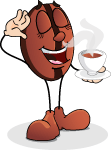|
Before speaking about coffee related concepts required while tasting coffee (without knowing them you won't be able to actually define all coffee characteristics), let's shortly revise the procedure itself. As it has been stated above, the process isn't difficult at all. Let's start from the very beginning. First of all, fill the cup with 2 spoons of coffee and then add boiling water to that cup. Let the consistence sit there for about 3 minutes so that the ground is soaked by water and a crust appears on the top. Break this husk by gently stirring the coffee mass and ensuring that most of the particles sink (those which rest on the surface should be thrown away). Now that the coffee liquid is ready, fill the tablespoon with coffee drink and slurp it with all your strength. Yes, just like that, we're serious. Don't be ashamed doing that, it will help you involve in the process as many nerve endings as possible. As soon as coffee is in your mouth, twirl the fluid around your mouth to feel all possible aromas and nuances it emits. And finally spit out this coffee and wash your mouth before tasting the next one. Okay, so the equipment is prepared, the techniques of tasting coffee are already studied. What's next? A little more patience before you can affirm with confidence you're a professional tester. Here are 4 major characteristics you should be attentive to while cupping: Odor - the first impression you get after the coffee grounds are being grinded and poured into your cup. All the flavors and essences it emits can already give you a lot of information about the type of coffee you'll drink.
Acidity - an arid feeling that has nothing to do with sourness or Ph. The term refers to fruity, tangy and winy tasting characteristics. These hints are found in Arabica coffee beans; they give certain savour to the coffee taste. The latter would be plain without acidity. Taste - is the combination of the primary receptors which define sourness, saltiness, sweetness and bitterness in your mouth. All the four in combination create the final taste of each coffee type. Body - is the feel of coffee heaviness in your mouth. As well as you sense the difference between wine and liquor where the first has an easier consistence and the second a heavier one, coffee, too, has its weight. The level of its mass depends on the type of bean roast, grinding and the way it has been brewed as well as the quantity of dry particles and the oils extracted form the coffee grounds. Don't search for a heavier or lighter body it doesn't affect the coffee quality. The most important thing you should know is that body can be light, medium or heavy. Aftertaste - the taste that remains in your mouth after you split the coffee amount you have been holding in your mouth for cupping. This phenomena is also called finish and signifies the tasting characteristics that can be sweet, chocolate, spicy (clove or resinous) and even tobacco. Congratulations, you can finally consider yourself a connoisseur in coffee cupping! Don't forget that each flavor, aroma nuances are applicable to your personal taste only. You can find such features in a coffee drink that are hardly perceptible for others, and vice versa. Your goal is to prove that the coffee you prepare and drink is good and tastes exactly as you like.
|
||||||||||||||||||||
Coffee Cupping
Coffee Cupping


 So what is coffee cupping or coffee tasting in other words? As follows from its name, this is the process of degustation the roasted coffee grounds infused with boiling water. The procedure is simple enough and is preformed by special coffee tasters as well as by common people at home. Anyone of us is able to learn how to properly taste coffee. Below are the necessary conditions and coffee cupping terms so that to know exact features to look for while sampling.
So what is coffee cupping or coffee tasting in other words? As follows from its name, this is the process of degustation the roasted coffee grounds infused with boiling water. The procedure is simple enough and is preformed by special coffee tasters as well as by common people at home. Anyone of us is able to learn how to properly taste coffee. Below are the necessary conditions and coffee cupping terms so that to know exact features to look for while sampling.






